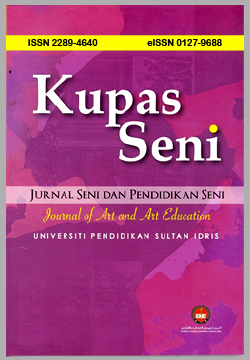Paper Art Wonder: Unlocking the Fundamental Origami Folding Techniques for Four-Years Old’s Masterpiece
DOI:
https://doi.org/10.37134/kupasseni.vol11.3.7.2023Keywords:
Origami Art, Paper Folding Technique & Early ChildhoodAbstract
Origami, the art of paper folding, has evolved over time. This art form involves intricate folding techniques that transform a single square sheet of paper into delicate, three-dimensional geometric creations. Origami stands as a unique and culturally enriched form of artwork, reflecting the essence of Japanese philosophy and heritage. Beyond its aesthetic appeal, origami offers a distinctive educational opportunity that allows young children to explore diverse perspectives. However, the complexity of established origami construction methods poses challenges for young learners, particularly four-year-olds. This study aims to address this gap by identifying fundamental origami folding techniques suitable for young children and offers potential insights into the intricate world of origami artistry. Through a pragmatic qualitative case study approach, the research assesses the appropriateness of various origami folding techniques for four-year-old children, considering their cognitive, psychomotor, and fine motor skills. The research findings demonstrate significant potential at the intersection of contemporary art, children's creative development, and academic research. Ultimately, this research provides valuable insights for educational practices that prioritize experiential learning concepts in supporting children's holistic growth. Additionally, it emphasizes the importance of adapting creative activities to suit young learners' developmental stages and promoting inclusive and enriching childhood experiences.
Downloads
References
Abdul Jamil, S.E.S., Ibrahim, N.H., Samsuddin, I., & Baharom, M. K. (2019). A study on the enfolded technique of origami art sensible among five years children in Perak, Malaysia. International Journal of Advanced and Applied Sciences, 6(6), 1-5. https://doi.org/10.21833/ijaas.2019.06.001.
Adetya, S., & Gina, F. (2022). Bermain origami untuk melatih keterampilan motorik halus anak usia dini. Altruis: Journal of Community Services. https://doi.org/10.22219/altruis.v3i2.21501.
Ahn, B., Shoji, D., Hansen, C., Hong, E., Dunand, D., & Lewis, J. (2010). Printed Origami Structures. Advanced Materials, 22. https://doi.org/10.1002/adma.200904232.
Ao, Q. (2022). How to design single-sheet origami models. 2022 IEEE Integrated STEM Education Conference (ISEC), 340-340. https://doi.org/10.1109/ISEC54952.2022.10025167.
Balaji, R. (2022). The STEM of origami. 2022 IEEE Integrated STEM Education Conference (ISEC), 380-380. https://doi.org/10.1109/isec54952.2022.10025216.
Bolitho, M. (2014). Zoogami: Fold Your Own Origami Wildlife Park. New York: Harper Design
Chen, K. (2005). Math in motion: origami math for students who are deaf and hard of hearing. Journal of deaf studies and deaf education, 11 2, 262-6. https://doi.org/10.1093/DEAFED/ENJ019.
Dere, Z. (2019). Investigating the creativity of children in early childhood education institutions. Universal Journal of Educational Research. https://doi.org/10.13189/UJER.2019.070302.
Fadli, Z., Hastuti, N., Ratna, M., Widiandari, A., & Sakariah, D. (2018). Brainstorming dini dengan origami untuk anak-anak., 2. https://doi.org/10.14710/HM.2.1.%P.
Flint, T. (2020). Responsive play: Creating transformative classroom spaces through play as a reader response. Journal of Early Childhood Literacy, 20, 385 - 410. https://doi.org/10.1177/1468798418763991.
Hanada, M. (2022). Introversion and high spatial ability is associated with origami proficiency. Frontiers in Psychology, 13. https://doi.org/10.3389/fpsyg.2022.825462.
Folami, A., Riaz, A., & Musolihu, M. (2021). Critical Environmental Factors Affecting Learning in College of Education. https://doi.org/10.35877/454ri.eduline400.
Gardiner, M. (2018). Everything Origami: Instructions for 55 Beautiful Models. Austrslia: Hinklers Book Pty Ltd.
Guinibert, M. (2020). Learn from your environment: A visual literacy learning model. Australasian Journal of Educational Technology, 36, 173-188. https://doi.org/10.14742/AJET.5200.
Hayakawa, H. (2009). Kirigami Menagerie: 38 Paper Animals to Copy and Cut. New York: Lark Craft an Imprint of Sterling Publishing Co., Inc.
Isa, B., & Forrest, D (2011). A qualitative case study of the implementation of education programs at the national gallery of Victoria (NGV), Australia. Procedia-Social and Behavioral Sciences, 29: 1905-1913
Julian, M., & Mccall, R. (2016). Social skills in children adopted from socially-emotionally depriving institutions. Adoption Quarterly, 19, 44 - 62. https://doi.org/10.1080/10926755.2015.1088106.
Kember, D., Webster, B., & Chan, W. (2020). Refocusing the 3P model to incorporate a learning and teaching environment and graduate attributes. Educational Psychology, 40, 592 - 607. https://doi.org/10.1080/01443410.2020.1732304.
Kikugawa, T. (Ed.). (2016). Akira Yoshizawa: Japan's Great Master. Japan: Turtle Publishing Ltd.
Letourneau, S., & Sobel, D. (2020). Children’s descriptions of playing and learning as related processes. PLoS ONE, 15. https://doi.org/10.1371/journal.pone.0230588
Musafir, M., Hadi, R., & Muhajirin, M. (2022). Meningkatkan kemampuan motorik halus anak melalui seni melipat origami pada anak kelompok b raudatul jannah. Jurnal Ilmiah Mandala Education. https://doi.org/10.58258/jime.v8i3.3692.
Nishida, Y. (2019). Something old, something new, something borrowed, and something froebel? The development of origami in early childhood education in Japan. Paedagogica Historica, 55, 529 - 547. https://doi.org/10.1080/00309230.2018.1546330.
Schmutz, E., Leeger-Aschmann, C., Kakebeeke, T., Zysset, A., Messerli-Bürgy, N., Stülb, K., Arhab, A., Meyer, A., Munsch, S., Puder, J., Jenni, O., & Kriemler, S. (2020). Motor competence and physical activity in early childhood: stability and relationships. Frontiers in Public Health, 8. https://doi.org/10.3389/fpubh.2020.00039.
Shi, P., & Feng, X. (2022). Motor skills and cognitive benefits in children and adolescents: relationship, mechanism, and perspectives. Frontiers in Psychology, 13. https://doi.org/10.3389/fpsyg.2022.1017825.
Sokolova, G. (2021). Origami as a means of geometric modeling: environmental approach to self-organization in young childhood. bulletin of kemerovo state university. Series: Humanities and Social Sciences. https://doi.org/10.21603/2542-1840-2021-5-3-229-237.
Yusiyaka, R., & Septina, H. (2022). Games based learning dengan media origami untuk menstimulasi kreativitas anak usia 6-12 tahun di pusat sumber belajar masyarakat bukit mekar wangi. Inspiratif Pendidikan. https://doi.org/10.24252/ip.v11i2.35496.
Downloads
Published
How to Cite
Issue
Section
License
Copyright (c) 2023 Siti Ermi Syahira Abdul Jamil, Mohd Khairi Baharom, Khayril Anwar Khairudin, Siti Maryam Ali Yasin

This work is licensed under a Creative Commons Attribution-NonCommercial-ShareAlike 4.0 International License.





